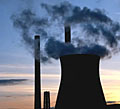
Experts at a major UN climate change conference in Bangkok have reached agreement on options for combatting global warming, delegates say.
It follows marathon talks with strong reservations voiced by China.
New clauses added at the last moment clarify the potential for nuclear power and lifestyle changes to cut emissions.
The third part of this year’s assessment from the Intergovernmental Panel on Climate Change looks at ways to curb emissions and economic factors.
The report is due to be released in the Thai capital on Friday.
‘Action needed’
“It’s all done,” Peter Lukey, a member of the South African delegation, told the Associated Press news agency.
“Everything we wanted to see was there and more. The message is: We have to do something now.”
The report makes clear that greenhouse gases are rising, and without intervention will continue to rise, with fossil fuels likely to remain the dominant energy supply for decades to come.
China repeatedly tried to tone down some elements of the draft text prepared for the start of the week-long discussions, delegates said.
It has been keen to remove references to scenarios which it fears could affect its short-term economic growth.
The Intergovernmental Panel on Climate Change (IPCC) has already this year produced the two other elements of this global assessment report – its fourth since 1990 – dealing respectively with the science of climate change and on the potential impacts.
Stable futures
The draft report assesses the likely costs to the global economy of stabilising greenhouse gases at various concentrations in the atmosphere.
Aiming for a total greenhouse gas concentration equivalent to 650 parts per million (ppm) of carbon dioxide would reduce global GDP by about 0.2%, it says, whereas a more ambitious target of 550ppm would cost about 0.6% of global GDP, says the BBC’s environment correspondent Richard Black.
The current atmospheric concentration is about 425ppm, and many climate scientists now argue that only agreeing to keep below about 450ppm can prevent major climatic consequences.
The IPCC draft says keeping concentrations at this level could cost up to 3% of GDP.
“I can tell you that the probability for achieving 450ppm in anything approaching the world as it now is almost impossible,” commented Professor Stephen Schneider from Stanford University in California, who helped draft the IPCC’s first report this year on the science of climate change.
“But a temperature rise over 2-3C leads to potential mass extinctions, serious problems with coasts, mountain glaciers disappearing, melting ice sheets… and one has to talk about stabilisation at 450-550ppm range to have a better than 20-30% chance of preventing that.”
The IPCC does not make policy recommendations, but even so China, with some other delegations, sought to play down references to the lower stabilisation levels.
Source: bbc.co.uk











Social Profiles